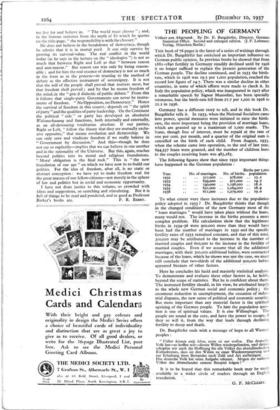THE PEOPLING OF GERMANY
THIS book of 76 pages is the latest of a series of writings through which Dr. Burgdoifer has exercised an important influence on German -public opinion. In previous books he showed that from 1881-1890 fertility in Germany steadily declined until by 1926 it no longer sufficed to replace the 'present generation of the German people. The decline continued, and in 1933 the birth- rate, which in 1926 was 19.5 per f,000 population, reached the record low figure of 14.7. There was a similar decline in other countries, in some of which efforts were made to check it. In Italy the population policy, which was inaugurated in 1927 after a remarkable speech by Signor Mussolini, has been specially strenuous, but the birth-rate fell from 27.7 per 1,000 in 1926 to
22.2 in 1936.
Germany has a different story to tell, and in this book Dr. Burgdorfer tells it. In 1933, when the National Socialists came into power, special measures were initiated to raise the birth- rate, the most important being the provision of marriage loans, which are granted up to a maximum of t,000 marks. The loans, though free of interest, must be repaid at the rate of one per cent, per month, and a quarter of the original sum is cancelled on the birth of each child. From August, 1933, when the scheme came into operation, to the end of last year, 694,357 loans were granted, and the number of children born to the couples receiving loans was 485,285.
The following figures show that since 1932 important things have happened to the German population : Year. No. of marriages. Births per 1,000 No. of births. population.
1932 .. 517,000 .. 978,000 .. r5.!
1933
639,000 971,000 .. 14.7 1934 740,000 . . 1,198,000 . . i8.o 1935 65 r,ocio . . 1,264,000 . . 18.9 1936 611,000 . . 1,279,000 . . 19.0 To what extent were these increases due to the population policy adopted in 1933? Dr. Burgdorfer thinks that though in the changed conditions of the new Germany most of the "loans marriages" would have taken place without the loans, many would not. The increase in the births presents a more complex problem. His calculations show that the legitimate births in 1934-36 were 900,000 more than they would have been had the number of marriages in 1932 and the specific fertility rates of 1933 remained constant, and that of this total, 300,000 may be attributed to the increase in the number of married couples and 600,000 to the increase in the fertility of married couples. Even if we assume -that all the additional marriages, with their 300,000 additional babies, were contracted because of the loans, which he-shows was not the case, we must still conclude that two-thirds of the additional 900,000 babies appeared because of other factors.
Here he concludes his lucid and masterly statistical analysis. To demonstrate and evaluate these other factors is, he holds,
beyond the scope of statistics. But he is confident about them. The increased fertility should, in his view, be attributed largely to the whole new German social and economic policy ; the
enormous reduction in unemployment, the cessation of indus- trial disputes, the new sense of political and economic security. But more important than any material factor is the spiritual
uprising of the German people. To him the population ques- tion is one of spiritual values. It is eine Willensfragi . The
people are sound at the core, and have the power to escape, if they so will it, from the way that leads through declining fertility to decay and death.
Dr. Burgdorfer ends with a message of hope to all Westerr. peoples :
" Volker konnen ewig leben, wean sie nur wollen. Das deutsch:. Volk hat—so hoffen wir—diesen Willen wiedergefunden, and darau, schopfen wir auch die Hoffnung fur alle Volker des abendlandischen Kulturkreises, dass sie den Willen zu einer Wiederemeuerung und zur Erhaltung ihres Bestandes each 'Zahl und Art aufbririgen. . . • Das deutsche Volk hit seine Aufgabe erkannt. Mogen die anderen VOlker des Abendlandes seinem Beispiel folgen l" It is to be hoped that this remarkable book may be made available to a wider circle of readers through an Engli,h translation.
G. F. McCLEARY.






















































 Previous page
Previous page